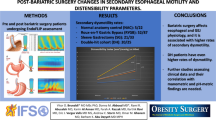Abstract
Background
During the past decade, laparoscopic adjustable gastric banding (LAGB) was one of the most popular surgical procedures in treating morbid obesity. Long-term effects, specifically on esophageal motility, of LAGB have not been well described in the literature despite the high prevalence of reoperations and post-operative dysphagia. We aimed to characterize esophageal dysmotility after long-term follow-up using data of high-resolution esophageal manometry (HRM) performed in patients who presented for LAGB removal. The research was conducted in Academic Hospital Center in the USA.
Methods
Research was conducted with approval from the institution’s Institutional Review Board. We included 25 consecutive patients who were requesting removal of the band or revisional bariatric surgery. All patients underwent HRM between 2011 and 2015.
Results
A Fisher’s exact test two-sided p value 0.41 shows no statistically significant difference in proportions of normal motility or impaired motility between asymptomatic and symptomatic patients.
Conclusions
Patients with a history of LABG can have esophageal dysmotility whether they are symptomatic or asymptomatic. Based on existing literature, we recommend pre-operative manometry in these patients requesting revisional surgery.
Similar content being viewed by others
References
Overweight and obesity viz | Institute for Health Metrics and Evaluation. http://www.healthdata.org/data-visualization/overweight-and-obesity-viz. Accessed 8 Jan 2017.
McTigue K, Larson JC, Valoski A, et al. Mortality and cardiac and vascular outcomes in extremely obese women. JAMA. 2006;296(1):79. doi:10.1001/jama.296.1.79.
Hinojosa MW, Varela JE, Parikh D, et al. National trends in use and outcome of laparoscopic adjustable gastric banding. Surg Obes Relat Dis. 2009;5(2):150–5. doi:10.1016/j.soard.2008.08.006.
Robert M, Golse N, Espalieu P, et al. Achalasia-like disorder after laparoscopic adjustable gastric banding: a reversible side effect? Obes Surg. 2012;22(5):704–11. doi:10.1007/s11695-012-0627-y.
DeMaria EJ. Laparoscopic adjustable silicone gastric banding: complications. J Laparoendosc Adv Surg Tech. 2003;13(4):271–7. doi:10.1089/109264203322333601.
Liu KH, Diana M, Vix M, et al. Revisional surgery after failed adjustable gastric banding: institutional experience with 90 consecutive cases. Surg Endosc. 2013;27(11):4044–8. https://doi.org/10.1007/s00464-013-3056-7.
Arias IE, Radulescu M, Stiegeler R, et al. Diagnosis and treatment of megaesophagus after adjustable gastric banding for morbid obesity. Surg Obes Relat Dis. 5(2):156–9. doi:10.1016/j.soard.2008.11.007.
Burton PR, Brown WA, Laurie C, et al. Pathophysiology of laparoscopic adjustable gastric bands: analysis and classification using high-resolution video manometry and a stress barium protocol. Obes Surg. 2010;20(1):19–29. doi:10.1007/s11695-009-9970-z.
Burton PR, Brown W, Laurie C, et al. The effect of laparoscopic adjustable gastric bands on esophageal motility and the gastroesophageal junction: analysis using high-resolution video manometry. Obes Surg. 2009;19(7):905–14. doi:10.1007/s11695-009-9845-3.
Burton PR, Brown WA, Laurie C, et al. Criteria for assessing esophageal motility in laparoscopic adjustable gastric band patients: the importance of the lower esophageal contractile segment. Obes Surg. 2010;20(3):316–25. doi:10.1007/s11695-009-0043-0.
Gamagaris Z, Patterson C, Schaye V, et al. Lap-band impact on the function of the esophagus. Obes Surg. 2008;18(10):1268–72. doi:10.1007/s11695-008-9601-0.
de Jong JR, van Ramshorst B, Timmer R, et al. Effect of laparoscopic gastric banding on esophageal motility. Obes Surg. 2006;16(1):52–8.
Suter M. Gastric banding interferes with esophageal motility and gastroesophageal reflux. Arch Surg. 2005;140(7):639. doi:10.1001/archsurg.140.7.639.
Rebecchi F, Rocchietto S, Giaccone C, et al. Gastroesophageal reflux disease and esophageal motility in morbidly obese patients submitted to laparoscopic adjustable silicone gastric banding or laparoscopic vertical banded gastroplasty. Surg Endosc. 2011;25(3):795–803. doi:10.1007/s00464-010-1257-x.
Korenkov M, Köhler L, Yücel N, et al. Esophageal motility and reflux symptoms before and after bariatric surgery. Obes Surg. 2002;12(1):72–6.
Iovino P, Angrisani L, Tremolaterra F, et al. Abnormal esophageal acid exposure is common in morbidly obese patients and improves after a successful lap-band system implantation. Surg Endosc. 2002;16(1):1631–5. doi:10.1007/s00464-001-9225-0.
Lew JI, Daud A, DiGorgi MF, et al. Preoperative esophageal manometry and outcome of laparoscopic adjustable silicone gastric banding. Surg Endosc. 2006;20(8):1242–7. doi:10.1007/s00464-005-0589-4.
Wiesner W, Hauser M, Schöb O, et al. Pseudo-achalasia following laparoscopically placed adjustable gastric banding. Obes Surg. 2001;11(4):513–8. doi:10.1381/096089201321209440.
Naef M, Mouton WG, Naef U, et al. Esophageal dysmotility disorders after laparoscopic gastric banding—an underestimated complication. Ann Surg. 2011;253(2):285–90. doi:10.1097/SLA.0b013e318206843e.
Klaus A, Gruber I, Wetscher G, et al. Prevalent esophageal body motility disorders underlie aggravation of GERD symptoms in morbidly obese patients following adjustable gastric banding. Arch Surg. 2006;141(3):247–51. doi:10.1001/archsurg.141.3.247.
Klaus A, Weiss H. Is preoperative manometry in restrictive bariatric procedures necessary? Obes Surg. 2008;18(8):1039–42. doi:10.1007/s11695-007-9399-1.
Khan A, Ren-Fielding C, Traube M. Potentially reversible pseudoachalasia after laparoscopic adjustable gastric banding. J Clin Gastroenterol. 2011;45(9):775–9. doi:10.1097/MCG.0b013e318226ae14.
Merrouche M, Sabaté JM, Jouet P, et al. Gastro-esophageal reflux and esophageal motility disorders in morbidly obese patients before and after bariatric surgery. Obes Surg. 2007;17(7):894–900.
Pescarus R, Sharata A, Shlomovitz E, et al. Endoscopic treatment for iatrogenic achalasia post-laparoscopic adjustable gastric banding. Surg Endosc. 2015; doi:10.1007/s00464-015-4561-7.
Vallin M, Robert M, Roman S, et al. Persistent dysphagia after removal of an adjustable gastric band for morbid obesity: a rare complication. Dis Esophagus. 2011;24(6):401–3. doi:10.1111/j.1442-2050.2010.01140.x.
Cruiziat C, Roman S, Robert M, et al. High resolution esophageal manometry evaluation in symptomatic patients after gastric banding for morbid obesity. Dig Liver Dis. 2011;43(2):116–20. doi:10.1016/j.dld.2010.08.011.
Naik RD, Choksi YA, Vaezi MF. Consequences of bariatric surgery on oesophageal function in health and disease. Nat Rev Gastroenterol Hepatol. 2015;13(2):111. doi:10.1038/nrgastro.2015.202.
Spechler SJ, Castell DO. Classification of oesophageal motility abnormalities. Gut. 2001;49(1):145–51. http://www.ncbi.nlm.nih.gov/pubmed/11413123. Accessed January 17, 2017
Author information
Authors and Affiliations
Corresponding author
Ethics declarations
Conflict of Interest
The authors declare that they have no conflict of interest.
Ethical Approval and Informed Consent
For this type of study, formal consent is not required as this was a retrospective study.
Human and Animal Rights
The article does not contain any studies with animal participants performed by any authors.
Funding
None of the authors have any relevant financial disclosures.
No grants were involved in the process of this research.
Rights and permissions
About this article
Cite this article
Tchokouani, L., Jayaram, A., Alenazi, N. et al. The Long-Term Effects of the Adjustable Gastric Band on Esophageal Motility in Patients Who Present for Band Removal. OBES SURG 28, 333–337 (2018). https://doi.org/10.1007/s11695-017-2842-z
Published:
Issue Date:
DOI: https://doi.org/10.1007/s11695-017-2842-z



